Австралия
http://www.hotkey.net.au/~ijcossor/jeepmila.html
E-mail: mailto:ijcossor@hotkey.net.au
Автор: Ian Cossor

This summary covers the open body style Jeep universal. The photo above is of a Bantam BRC-40 towing a 37mm anti-tank gun while on US Army trials in 1941.
This site is located in Australia.

In the beginning...
Since at least as early as World War I, the United States Army had been looking for a fast, lightweight, all-terrain command and reconnaissance vehicle. In early 1940, as Nazi Germany began to win victories in Europe and North Africa, the need to rapidly develop this type of vehicle became urgent. The U.S. Army sent out specifications to car manufacturers asking for a working prototype vehicle to be delivered in only 49 days!
The American Bantam Car Company (formerly The American Austin Car Company) and Willys-Overland were the only two companies that responded to the Army's request, although 135 companies had been contacted.
The depression of the 1930's had sent The American Austin Car Company broke, and American Bantam, which had been formed in the subsequent reorganisation had fared little better. By the time the Army asked for expressions of interest in a new command and reconnaissance car, production at American Bantam had ceased and they had no engineering staff left on the payroll.
The 49-day deadline was a huge problem, and Willys-Overland asked for more time to finish their vehicle but were refused by the Army.
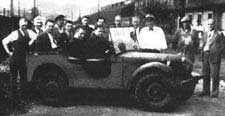 Bantam's only chance to meet this deadline was to bring in outside
help. Bantam's savior was Karl Probst, a talented freelance engineer from Detroit.
Bantam's only chance to meet this deadline was to bring in outside
help. Bantam's savior was Karl Probst, a talented freelance engineer from Detroit.
After turning down an initial request from Bantam, Probst accepted the job after being asked again by the Army, and initially working without salary, went to work July 17, 1940.
Above: This is the first Bantam prototype just prior to delivery, Designer Karl Probst in the passenger seat and Bantam manager, Harold Crist in the drivers seat. Note the rounded front fenders and grill.
In only two days Probst had completely laid out plans for the Bantam prototype, and the next day he estimated the total cost of the vehicle. On July 22, Bantam's bid was submitted, complete with blueprints. The bid claimed that the vehicle met the weight limit of 1,300 pounds (590 kg) although it was actually much heavier.
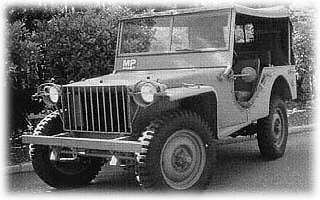 Much of the vehicle had to be assembled from existing
off-the-shelf automotive parts, and the custom four wheel drive train components were
supplied by Spicer. As the principal sub-contractor, Spicer's ability to manufacture the
running gear in time was critical to Bantam's chance of meeting the Army deadline.
Much of the vehicle had to be assembled from existing
off-the-shelf automotive parts, and the custom four wheel drive train components were
supplied by Spicer. As the principal sub-contractor, Spicer's ability to manufacture the
running gear in time was critical to Bantam's chance of meeting the Army deadline.
Bantam's first hand-built prototype was complete and running by
September 21, 1940, just meeting the 49-day deadline and was delivered to the Army for
testing at Camp Holabird, MD. The Quartermaster Corps put this prototype through torturous
off road trials, after which the testers concluded "this vehicle demonstrated ample
power and all requirements of the service."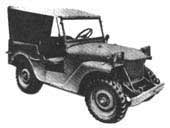
Willys-Overland and Ford soon submitted prototypes based on the Bantam plans (supplied to them by the Army). Spicer supplied almost identical four wheel drive trains to all three manufacturers. The Willys "Quad" and the Ford "Pygmy" prototypes added their own changes and modifications to the basic Bantam design.
Right: The Willys 'Quad' Prototype.
This ultimately worked to Willys advantage when the weight limit was
increased: it was the only vehicle that met the Army's power specifications. In fact, the
Willys 60 horse power "Go Devil" engine, with 105 foot-pounds of torque not only
exceeded the required power, but dwarfed Bantam's 83 and Ford's 85 pound-feet of torque. 
All three prototypes passed army testing satisfactorily, with changes being made to correct faults in the prototypes. The Army ordered 1500 units from each of the three companies. Ford started deliveries in April 1941 with Bantam and Willys a few weeks later.
Left: The Ford 'Pygmy' Prototype.
Once delivered, they started a revolution in the use of small military motor vehicles in the U.S. Army. Motorcycles, solo and side car, were rendered obsolete almost immediately.
In light of Bantam's shaky manufacturing and financial position, and the advantages of the Willys-Overland vehicle and their proven production capacity, the final mass production Army contract was awarded to Willys-Overland. The price was $749 each.
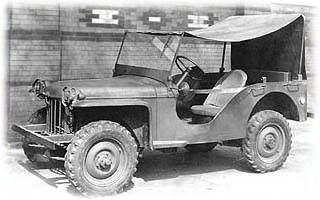 Since the War Department required a large number of vehicles to be manufactured
in a relatively short time, Willys-Overland granted the United States Government a
non-exclusive license to allow another company to manufacture vehicles using Willys'
specifications. The Army chose Ford as the second supplier, but building Jeeps to the
Willys' design. Willys supplied Ford with a complete set of plans and specifications.
Since the War Department required a large number of vehicles to be manufactured
in a relatively short time, Willys-Overland granted the United States Government a
non-exclusive license to allow another company to manufacture vehicles using Willys'
specifications. The Army chose Ford as the second supplier, but building Jeeps to the
Willys' design. Willys supplied Ford with a complete set of plans and specifications.
Sadly, American Bantam, the creators of the first Jeep, spent the rest of the war building heavy duty trailers for the army and finally sold out in 1956. Willys registered Jeep as a trademark in 1950 but cannot claim that they designed the Jeep.
 By the time the United States entered the War in August 1941, Jeep production
was in full swing. About 640,000 Jeeps were built in the four years until the end of the
war in 1945. Over 360,000 of these were manufactured by Willys and the balance by Ford.
This was about 18% of all the wheeled military vehicles built in the US during the War.
By the time the United States entered the War in August 1941, Jeep production
was in full swing. About 640,000 Jeeps were built in the four years until the end of the
war in 1945. Over 360,000 of these were manufactured by Willys and the balance by Ford.
This was about 18% of all the wheeled military vehicles built in the US during the War.
Right: The final Jeep production model, a Willys MB (Model B). The Ford GPW was almost identical.
Jeep vehicles were used by every division of the U.S. Military and 144 Jeeps were supplied to every infantry regiment in the U.S. Army. Large numbers of Jeeps were shipped to the Allied Forces of Britain and Russia - nearly 30% of total Jeep production.
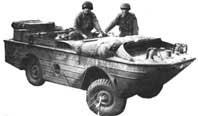 An amphibious version was also produced called a Seep. They were not a military
success as they were too small to be a good boat, and too cumbersome to be a good Jeep.
Only about 18,000 were built by Ford.
An amphibious version was also produced called a Seep. They were not a military
success as they were too small to be a good boat, and too cumbersome to be a good Jeep.
Only about 18,000 were built by Ford.
Left: A Ford GPA (Seep).
Jeeps could be fitted with .30" or .50" calibre machine guns for combat. They were also widely modified for long range desert patrol, snow ploughing, telephone cable laying, saw milling, as fire fighting pumpers, field ambulances, tractors and, with suitable wheels, would even run on railway tracks.
Jeeps could be loaded into transport aircraft for rapid deployment and were also small enough to fit into the large gliders used in the D-day invasion of Europe.
General George C. Marshall, US Army Chief of Staff during World War II, and later Secretary of State, described the Jeep as "America's greatest contribution to modern warfare". The tough, simple, go anywhere Jeep became the GI's best friend - second only to his rifle.
There is no way to know for certain where the name 'Jeep' came from, but it was slang for some time before World War II. The US Army motor pool used the word to describe any new vehicle received for testing.
 One of the most likely explanations for how the word was used for
the Army's new four wheel drive car was from the character 'Eugene the Jeep', who was the
creation of E.C. Segar, in the very widely read 'Popeye' comic strip. Eugene was small,
able to move between dimensions and could solve seemingly impossible problems.
One of the most likely explanations for how the word was used for
the Army's new four wheel drive car was from the character 'Eugene the Jeep', who was the
creation of E.C. Segar, in the very widely read 'Popeye' comic strip. Eugene was small,
able to move between dimensions and could solve seemingly impossible problems.
Right: Eugene the Jeep
If you have any suggestion or comments about this page
(factual errors for example) contact Ian Cossor.